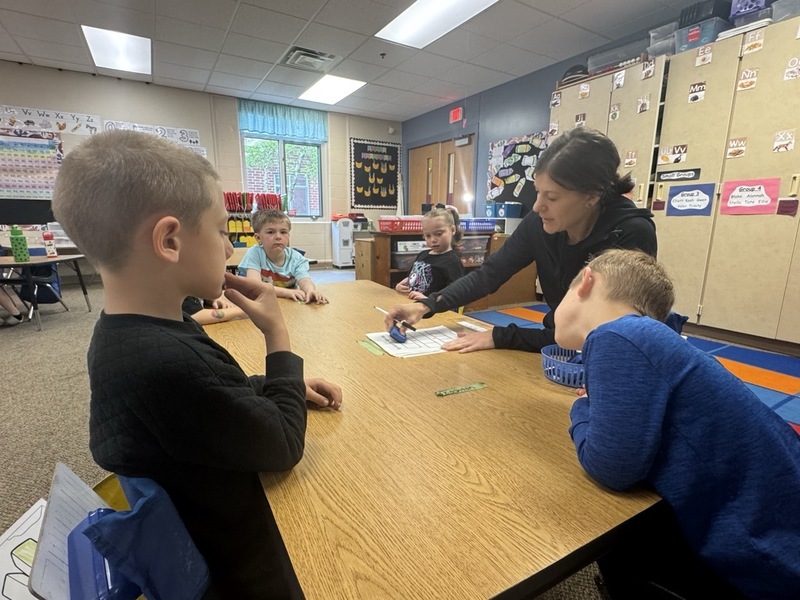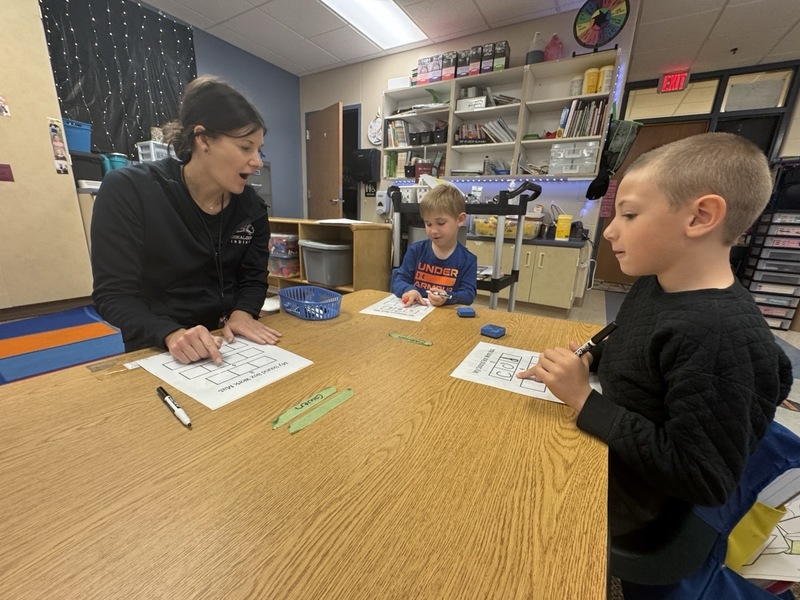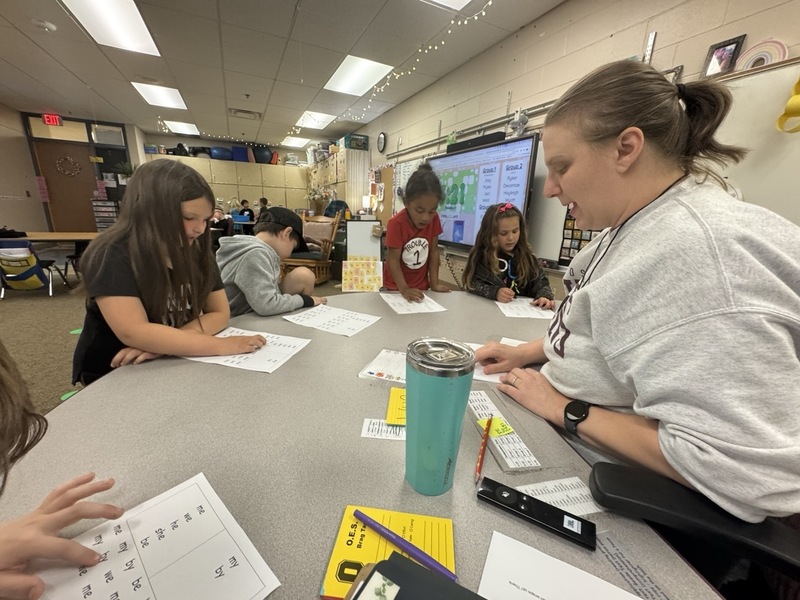Oskaloosa Elementary Sees Literacy Soar with New Teaching Model
 At Oskaloosa Elementary School, reallocating an additional educator from pulling students out of the classroom to pushing extra teachers into the classroom has led to extraordinary gains in early literacy in just one year. With 91% of kindergarten students now meeting or exceeding reading benchmarks on assessment tools designed for universal screening, and two classrooms reaching 100% proficiency, teachers and staff are celebrating a transformation that is not only changing academic outcomes but also setting a new standard for early intervention and collaboration.
At Oskaloosa Elementary School, reallocating an additional educator from pulling students out of the classroom to pushing extra teachers into the classroom has led to extraordinary gains in early literacy in just one year. With 91% of kindergarten students now meeting or exceeding reading benchmarks on assessment tools designed for universal screening, and two classrooms reaching 100% proficiency, teachers and staff are celebrating a transformation that is not only changing academic outcomes but also setting a new standard for early intervention and collaboration.
One of the biggest highlights came in Kindergarten. Winter screening for the 2024-25 school year showed 91% of Kindergarteners meeting the proficiency benchmark compared to only 66% of kindergarten students in the previous school year. That’s a monumental improvement and reflects the school’s power in early literacy work and a new model of teaching and learning.
Steady Growth Across All Grades
OES has a year-end goal of having 80% of students reading at or above grade level. While not there yet, they are making steady progress. On average, OES saw a 6.7 percentage point increase per grade in the number of students who were proficient from fall to winter.
F ourth grade led the way, jumping 18 points from 55% in the fall to 73% in the winter. That kind of growth is exciting, and it’s about a team approach that teachers led the implementation of over the summer.
ourth grade led the way, jumping 18 points from 55% in the fall to 73% in the winter. That kind of growth is exciting, and it’s about a team approach that teachers led the implementation of over the summer.
When a team of educators visited Storm Lake to observe a new instructional model, the takeaway was immediate. “This is what we've needed,” said Katie Fox, a Kindergarten teacher at Oskaloosa Elementary School for the last 10 years. “It felt like a big, scary jump, but we were unanimous… let’s do it.”
The Shift to Specialist-Driven Support
The new model includes literacy specialists who rotate among the classrooms each day. In short 20-minute blocks, Amy Blythe, one of the specialists, provides focused, small-group instruction alongside the classroom teacher and another support staff member. “Having three teachers in the room versus one has made a massive difference,” Fox said. “Last year, small group time could fall apart if I had to stop and help with technology or a bathroom need. This year, every child gets seen by a teacher every day.”
That one-on-one attention is paying off. “We have kids reading passages and stories that we just haven’t seen in the last couple of years,” said Fox. “It’s an hour and 20 minutes a day, and the growth is amazing.”
For Blythe, the focused scope of her work has also changed the game. Previously, as a Title I education teacher who pulled students out of the classroom, she supported more than 45 students across multiple grade levels. Now, she works solely with kindergarten. “I know all of my students individually much better,” she said. “It’s allowed me to tailor instruction in ways I couldn’t before.”
The gains are more than academic. “When kids struggle, they get frustrated. That can lead to behavioral issues,” Blythe explained. “But when they’re successful, they’re confident. That changes everything.”
A Collaborative Effort Drives Success
Becky Cassens, an Oskaloosa Elementary School paraeducator, believes that student literacy growth success is a result of a collaborative effort between teachers, specialists, and the students.  "The small group work we do with consistent repetition really helps reinforce what the kids are learning," she explained. Cassens works with 27 groups of students every day, providing individualized instruction in seven-minute sessions. The repetition and continuity in these sessions, along with the integrated approach used across the grade level team, ensure that all students receive the same high-quality exposure to foundational skills.
"The small group work we do with consistent repetition really helps reinforce what the kids are learning," she explained. Cassens works with 27 groups of students every day, providing individualized instruction in seven-minute sessions. The repetition and continuity in these sessions, along with the integrated approach used across the grade level team, ensure that all students receive the same high-quality exposure to foundational skills.
Cassens also highlights the shift in teaching methods that has occurred over the last couple of years. The introduction of specialists working alongside classroom teachers has allowed for more focused, small-group instruction, meeting students where they are in their learning journey. “The kids really took to it and responded positively,” she shared. After piloting the program last year, the team saw impressive results that only grew as the program was fully implemented. Cassens expressed her excitement about the continued success, stating, “I couldn’t be happier with the results we’re seeing, and I hope it continues.”
Kindergarteners at 100%
 Kasey Koehler, a kindergarten teacher at Oskaloosa Elementary School, attributes the impressive growth in her students' literacy proficiency to the collaborative approach that involves specialists co-teaching in the classroom. “Having the specialists come in for literacy and co-teach during both Fundations and small group sessions has been a game-changer,” she explained. By working in tandem with her co-teacher specialist, Koehler is able to provide individualized attention to her students, ensuring they receive consistent, focused support. This approach has proven effective. Two Kindergarten classrooms actually scored 100% proficient.
Kasey Koehler, a kindergarten teacher at Oskaloosa Elementary School, attributes the impressive growth in her students' literacy proficiency to the collaborative approach that involves specialists co-teaching in the classroom. “Having the specialists come in for literacy and co-teach during both Fundations and small group sessions has been a game-changer,” she explained. By working in tandem with her co-teacher specialist, Koehler is able to provide individualized attention to her students, ensuring they receive consistent, focused support. This approach has proven effective. Two Kindergarten classrooms actually scored 100% proficient.
Koehler emphasized that this level of collaboration is unique and has had a lasting impact on her classroom. “I’ve never worked in a situation where we had specialists come in to co-teach phonics and small group lessons,” she said. “It’s such a huge asset to our program.” She believes the program’s success has given parents in the community strong reasons to feel confident in their children’s education at Oskaloosa Elementary. “Seeing the results, I would encourage parents to be incredibly proud that their kids are part of this program,” Koehler shared, reinforcing the high level of commitment and achievement taking place within the school.
What sets this model apart isn’t just extra staffing; it’s the structured collaboration time embedded in the schedule. Teachers and specialists meet three times a week in small squads, and then again twice a week as a whole team. These sessions allow them to adjust instruction based on student needs. “We’re talking about what we’re seeing in the classroom, whether we need to move students between groups, and how we can make our teaching better,” Fox said. “Just today, we noticed one group struggled with two specific words, so now we know what to target.”
Agility in Instruction for Every Student's Needs
 Thanks to that agility, students who’ve mastered kindergarten standards are moving ahead. “We’re already pre-teaching first-grade skills,” said Fox. “They’re reading passages and working on content we normally wouldn’t get to until much later. Everyone is getting what they need, no matter where they’re at.”
Thanks to that agility, students who’ve mastered kindergarten standards are moving ahead. “We’re already pre-teaching first-grade skills,” said Fox. “They’re reading passages and working on content we normally wouldn’t get to until much later. Everyone is getting what they need, no matter where they’re at.”
The success has created a ripple effect that teachers believe will carry forward for years to come. “We’ve talked about what this will look like when they’re in fifth grade,” Fox said. “Even next year, we’re excited to hear from the first-grade teachers. We met with them at the start of the year to ask what we could improve on, things like blending and handwriting, and we’ve really focused on those.”
For families, the results are both emotional and affirming. “When the scores came back, we were crying,” Fox recalled. “The kids were excited to see their growth. They track it with graphs and come celebrate with us. You should be excited for what this means for your child.”
That excitement is rooted in a deep understanding of the long-term impact of early literacy. “It’s all about early intervention,” said Blythe. “When we catch them early, we set them up for a lifetime of success.”
In just one school year, a bold staffing change and a commitment to collaboration have reshaped what’s possible in Oskaloosa’s Elementary School classrooms. With data-backed success and joyful momentum, teachers are proving that when you invest early, the payoff for students, families, and the future is immeasurable.

Kindergarten students at Oskaloosa Elementary work in small groups during a literacy block, supported by a team of educators who rotate into the classroom to provide individualized instruction. The collaborative model is credited with dramatic gains in reading proficiency.

